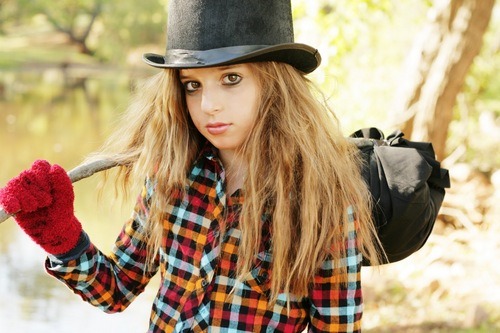
Tween Hobo is the name of a Twitter feed, and also the name of a fictional character, one of the most imaginative uses for Twitter so far. Frequently snarky and more than just faintly ridiculous, the tweets establish and re-establish her contradictory, silly invented identity as a relentlessly chirpy kid who rides the rails, “a solitary, capable highwayman with a high side pony tail,” according to her tweet of May 20. She’s two incompatible stereotypes, all the time, with the real tastes of stereotypical tweens (Justin Bieber) and the habits of popular imagination’s bindle-on-shoulder hobos: “I take life like I take my gummy bears: head first,” she wrote on May 18. Other recent tweets describe her future daughter, Pineapple Chloe Bieber, now “negative 15 years old,” and her traveling companions Blind Hank and Salt Chunk Annie, Toothpick Frank and Slaughterhouse Bill. “Any’a you drunken stiffs have a hair thing I can borrow?”
Other writers have tried to make Twitter literary, but the most prominent—in English, at least—have made of it not much more than a means of transmission: a substitute for the page, or the comedy club, or the works of Felix Fénéon. Because it keeps going while you’re not watching, though, Twitter suits not narrative but character, revealed in every utterance, every character-string, so that no single one becomes unmissable. The right work for Twitter would not take itself too seriously, and would reveal a fictional character—ideally one who could not exist in real life, or on film—in ways that took advantage of the medium’s compression, its forgetfulness, its intricate links between life online and offline, and its emphasis on the social, on the mobile, on anything that might change in a couple of blinks.
Tween Hobo is it. Her work passes what we might call (after G.E. Lessing) the Laocoön test: it could only be a Twitter feed, not a book, not a video, not a stage show. It’s ephemeral, pop-culture-driven, yet available in retrospect—an archive of stichomythia, allusion, and repartee. Sometimes it just unpacks the latest pop meme, in aggressively anachronistic ways: “I ain’t saying she’s a gold digger, but she is panning for gold in the Yukon Territory.” The best jokes, though, come from collisions between Then and Now, age and youth, tweenness and patched-hat hobodom. “Of all the desolate places, MySpace is the worst.” “A hobo’s gotta live by the whimsicalities of chance, for example I keep my iPod on shuffle.”
Tweens belong to the present, cutely or obnoxiously: they’re pink-lipgloss consumers, transparent in their love for the all-too-brand-new. Stereotypical hoboes (as opposed to real homeless travelers) belong to the long-ago past, dead as FDR. Tweens are defined by consumption: they need pocket...
You have reached your article limit
Sign up for a digital subscription and continue reading all new issues, plus our entire archives, for just $1.50/month.
Already a subscriber? Sign in




